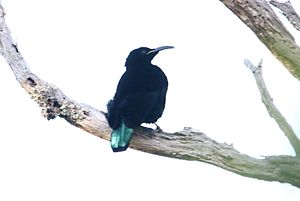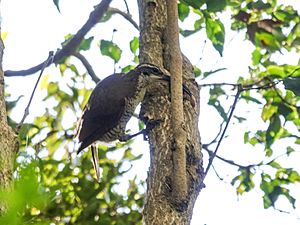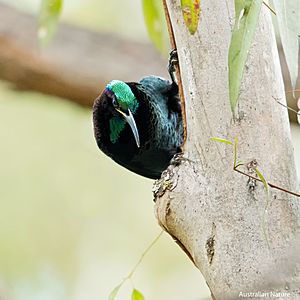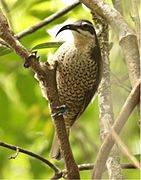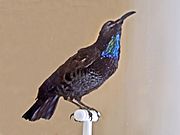Paradise riflebird facts for kids
The paradise riflebird (Lophorina paradisea) is a special bird from the bird-of-paradise family. You can find it in the warm, wet rainforests of eastern Australia. This bird is quite unique because the males and females look very different. The male paradise riflebird is mostly black with shiny blue-green patches, while the female is gray-brown and white.
These birds love to eat both fruit and insects. When it's time to find a mate, the male puts on an amazing show! He moves quickly from side to side, tilting his head back to show off his bright, colorful neck feathers to attract a female.
Quick facts for kids Paradise riflebird |
|
|---|---|
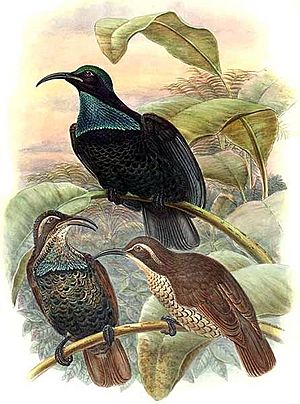 |
|
| Illustration from IOC World Bird List | |
| Conservation status | |
| Scientific classification | |
| Genus: |
Lophorina
|
| Species: |
paradisea
|
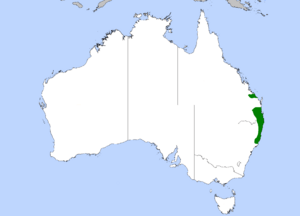 |
|
| Green indicates the range of the paradise riflebird | |
| Synonyms | |
|
Ptiloris paradiseus Swainson, 1825 |
|
Contents
Understanding the Paradise Riflebird's Name
The paradise riflebird was first described by a scientist named William Swainson in 1825. For a long time, it was grouped with other "riflebirds" in a genus called Ptiloris. But recently, after scientists did new genetic tests, they moved it to a different group called Lophorina. This new group also includes the superb birds of paradise.
The name Lophorina comes from two old Greek words: lophos, meaning "crest" or "tuft," and rhinos, meaning "nose." This name was first used for superb birds of paradise, which have tufts near their noses. Even though riflebirds don't have these tufts, they are now part of this group.
The common name "riflebird" might make you think of guns, but it actually comes from how the bird's dark, velvety feathers look like the uniforms worn by the British Army's Rifle Brigade.
There are no different types (subspecies) of the paradise riflebird known today. It looks similar to other riflebird species, with males having those shiny blue-green patches and females being gray-brown with striped patterns on their undersides.
What Does the Paradise Riflebird Look Like?
The paradise riflebird is a medium-sized bird. Male birds are usually about 30 cm (11.8 in) tall and weigh around 134 to 155 grams (4.7 to 5.5 oz). Females are a bit smaller, about 29 cm (11.4 in) tall and weighing 86 to 112 grams (3.0 to 3.9 oz). Both males and females have a long, black beak that curves downwards, black legs, and dark brown eyes.
Male and Female Differences
Male and female paradise riflebirds look very different from each other. This is called sexual dimorphism.
The adult male is mostly black. He has shiny greenish-blue feathers on his head (crown), throat, and the middle of his tail. He also has shiny green feathers on his lower chest. The middle tail feathers are shorter, making the tail look blue over black. Scientists think some of the male's black feathers are "super black." These feathers are specially made to absorb almost all light, making them look extra dark. This helps the bright, colorful patches next to them stand out even more during his courtship dances.
The adult female is gray-brown. She has reddish-brown feathers on her wings, except for a white stripe above her eye. Her throat is white, and her chest, sides, and belly are lighter brown with a striped pattern. The female's beak is noticeably longer and more curved than the male's.
Young paradise riflebirds, both male and female, look like the adult female, with gray-brown feathers.
Sounds and Calls
Like the Victoria's riflebird and the growling riflebird, the paradise riflebird makes a growling sound. The male is famous for his loud "yaassss" call, which he often repeats. Each call lasts about 2 seconds.
Where the Paradise Riflebird Lives
The paradise riflebird lives only in eastern Australia, from New South Wales to Queensland. It prefers to live in rainforests, usually high up in the trees, above 500 meters (1640 ft) in elevation. However, in winter, it might move to lower areas, sometimes below 200 meters (656 ft).
These birds usually stay in one place and don't have many neighbors. But sometimes, they might move short distances from wet rainforests to nearby sclerophyll forests, which are drier forests with tough-leaved plants.
Paradise Riflebird Behavior and Reproduction
The paradise riflebird mainly eats insects and fruit, which it finds high up in the forest canopy. Sometimes, a few birds (6-7) might gather to look for food together. But usually, they are solitary birds, meaning they prefer to be alone and don't defend a specific area.
Breeding and Courtship
Breeding season for the paradise riflebird is from August to February, which is spring and summer in Australia. Like other birds of paradise, the male paradise riflebird mates with more than one female.
The male performs a special display for females by himself. He does this from low branches that are easy to see in the forest canopy. Even though these birds usually don't defend territories, males might protect these special display spots during mating season.
His courtship dance involves quick side-to-side movements of his wings, which he holds out flat like other riflebirds. He also moves his head quickly, opening his mouth wide to show off the shiny blue-green feathers on his throat. Scientists believe his "super black" feathers help make the bright, colorful patches look even more amazing during these dances.
Nesting and Young
The female paradise riflebird takes care of her young all by herself. Their nests are similar in shape to those of the Victoria's riflebird, but they are bigger and more bulky. On average, a female will lay two eggs at a time.
Status and How Humans Affect Them
In the past, people hunted the paradise riflebird for its beautiful feathers. Today, its biggest threats are deforestation (when forests are cut down) and rainforest fragmentation (when large forests are broken into smaller pieces). Because these birds tend to stay in one place and don't have large populations, they are very sensitive to losing their habitat.
Currently, the paradise riflebird is listed as a species of Least Concern by conservation groups. This means it's not in immediate danger of disappearing. However, its numbers are slowly going down, so it's important to protect their rainforest homes.
Gallery
See also
 In Spanish: Ave del paraíso festoneada para niños
In Spanish: Ave del paraíso festoneada para niños



